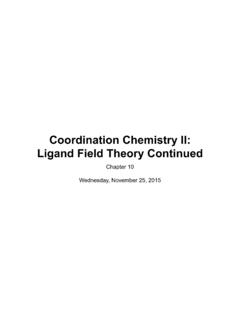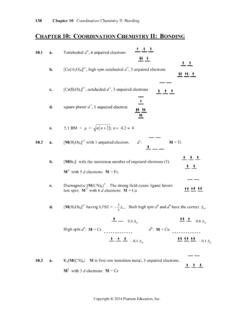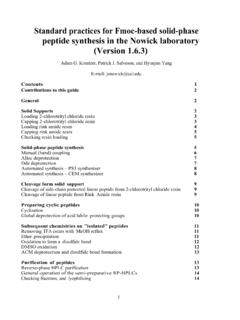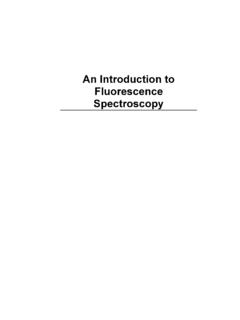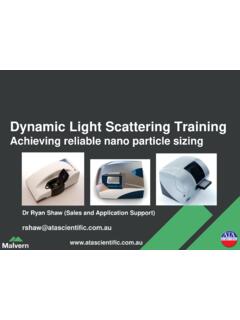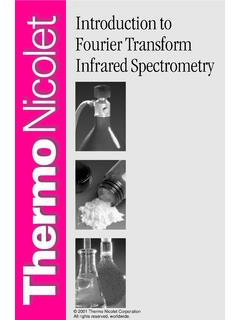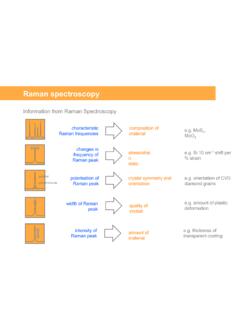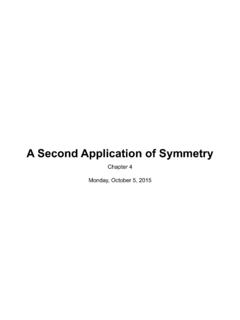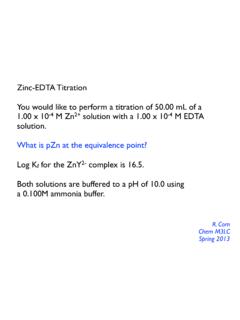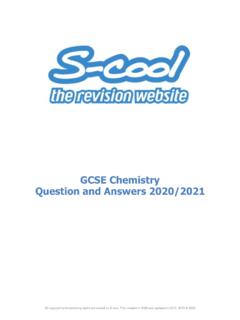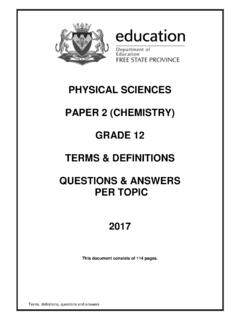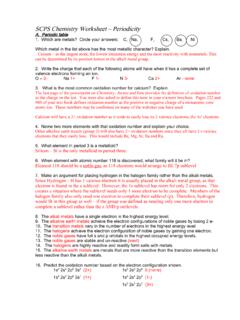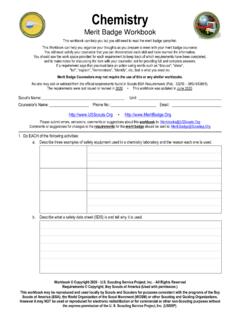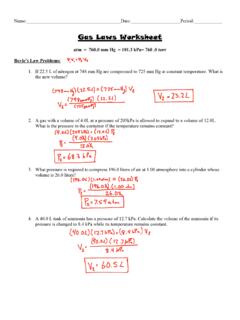Transcription of Introduction to Kinetics and Equilibrium
1 Introduction to Kinetics and EquilibriumKinetics and Equilibrium are two of the most importantareasinchemistryEntirebooksandi mportant areas in chemistry . Entire books and courses at the undergraduate and graduate level are devoted to them. Chemical Kinetics the study of the rates of chemical processesEquilibrium the condition of a system in which competing influences are balancedChi lilib ithttihi hthttifthChemical Equilibrium the state in which the concentrations of thereactants and products have no net change over time13concentrations at Equilibrium aredetermined by thermodynamics ( rG )Physical Equilibrium14 Chemical Equilibrium1516Is Equilibrium Common?17 Demo Equilibrium 1: Hpressure balancedWe have physical Equilibrium : Equilibrium 1: H2pressure balanced by balloon wall surface tension Equilibrium 2: Balloon buoyancy H2and O2filled balloonqyybalanced by the string tensionballoonDo we have chemical Equilibrium ?
2 ? NO!Do we have chemical Equilibrium ?? NO!2 H2 (g)+ O2 (g) 2H2O(g) rG = kJ/mol Combustion to make water is favored, but extremely slow at PSCB 100 temp. Removing constraints: heating with candle18 Removing constraints: heating with candledestroys equilibria 1&2 and (nearly) achieveschemical Equilibrium simultaneouslyLimiting ReagentsWas all the H2and O2in the balloon converted to water?It depends on the initial amounts of the two gases Suppose:It depends on the initial amounts of the two gases. Suppose:2 H2 (g)+ O2 (g) 2H2O(g)Before candle: atm atmAfter atm075atmChange: -2x -x+ 2xAfter candle: atmLimiting reagent:80 s Australian rock band? ?Reagent in excessLimiting reagent:molecule that is used up, causing the reaction to stopg19 Reactions That Don't Go to CompletionReactions either: go to completion (all limiting reactants are consumed)gp(g) egcombustionreactions(liketheballoondemo )reactants products e.
3 G. combustion reactions (like the balloondemo) or establish a chemical Equilibrium (some reactants, some products)reactants products these are the reactions introduced in this part of the course20 Reactions That Don't Go to Completion When an Equilibrium is established, each reactant (and product) has a idhiihnonzero concentration and these concentrations are constant with respect to time. When an Equilibrium is established, the limiting reagent has a nonzero concentration. The reactions do not stop at Equilibrium . The rates of the forward and reverse reactions are balanced, so there is no net change in is specified as Moles per Literand written as [reactant] or [product],or 21as partial pressures for gas phase reactionsA Gas Phase EquilibriumConsider a simple gas phase reaction, the conversion of cis 2 butene to trans 2 butene,anexampleofisomerization:trans2bu tene, an example of isomerization:H3 CCH3H3 CHCCHHCCCH3 Hcis2butenetrans2butenecis 2 butenetrans 2 butene The is used to indicate an Equilibrium .
4 Here, both species are gases. The total number of moles of gas remains constant. This reaction does not go to An Equilibrium is Gas Phase Equilibriumcis transat 400 CKinetic region Equilibrium region23 Equilibrium Constant In the Equilibrium region, the concentrations of products and reactants are related in an equation called the Equilibrium constant expression In the 2 butene case, cis trans(at 400 C) Kcis called the Equilibrium constant. For Kc,species are expressed as M(Moles L 1) Productsinnumerator, in numerator, reactants in denominator. Concentrations raised to their stoichiometric coefficients in the balanced reaction (1 in this case).24 Sample QuestionA quantity of cis-2-butene is added toa2 Literflaskandheated to 400 C for2 years. The concentration of trans-2-butene was then determined to be Equilibrium ConstantaA+bBcC+dDa A + b B c C + d DConstant for a giventemperature Ratio of Equilibrium concentrations of products over reactants Concentrations raised to the stoichiometric coefficients in thebalanced reaction equation2627 Equilibrium Constant28 Origin of Equilibrium ConstantEquilibrium occurs when the ratesof the forward and reverse reactions are exactly equalrateforward= ratereverseReaction rate is the number (mol) of molecules produced or dih i ltitil(L)ti()consumed in a chemical reaction per reaction volume (L) per time (s) rateforwardrate29rateforwardOrigin of Equilibrium ConstantFor simple reactions (like this one), reaction rate is proportional to the concentrations of the reactants raised to their stoichiometric coefficients rateforwardRate definition.
5 Ratereverserateforward= kfx [A]ratereverse= krx [B]Rate law:rate constantsAt Equilibrium :kfx [A] = krx [B]Kc=30frcExampleThe reaction of CO with Cl2to form COCl2is another single-step reaction. A vessel is filled with only CO and Cl2. Describe how Equilibrium is achieved and the connection between the reaction rates and the Equilibrium Reaction:connection between the reaction rates and the Equilibrium constant. CO (g)+ Cl2(g) COCl2(g)rateforward= kfx [CO][Cl2]Initially, we have only reactants:CO(g) + Cl2(g) COCl2(g)forwardf[][2]Initially: rateforward>> ratereverseAs products form, the rate of the reverse reaction increases:CO(g) + Cl2(g) COCl2(g)31ratereverse= krx [COCl2]When the forward and reverse rates become equal, the system has q,yachieved chemical ratereverseEquilibriumconstantexpression Equilibriumconstantconstant expression= constantLaw of Mass Action Products in numerator, reactants in denominator.
6 By convention, the units of Kc(if any) are ignored32 Concentrations raised to the stoichiometric coefficients (1 in this case). Equilibrium Expressed in Partial Pressures a A + b B c C + d DSince PV = nRT, we can write for gas phase reactions:Kpexpresses Equilibrium in terms of the partial pressures 33 Equilibrium Expressed in Partial Pressures In generalKc Kp, but they are related:34 Sample Problem35 Homogeneous EquilibriaRefers to reactions in which all reactants and products are in the same phase. 36 Heterogeneous EquilibriaIn heterogeneous equilibria, reactants and products are in different phasesThe concentrations of pure solids and pure liquids are constant and are not included in the expression for the Equilibrium constant 3738 Example39 Manipulating Equilibrium Constant Expressions Each of these proper chemical equations will have a different Equilibrium expression and a different numerical value of Kc.
7 N2(g) + 3H2(g) 2NH3(g)1/2N2(g) + 3/2H2(g) NH3(g)2NH3(g) N2(g) + 3H2(g) Changing the reaction stoichiometry by a factor of xraises Kcto the power of x41 The Kc s of a forward and reverse reaction are reciprocals of each other Kof Forward and Reverse Reactions42 Multiple Equilibria43 ExampleN2 (g) +O2 (g) 2 NO (g) 2 NO(g) + O2(g) 2 NO2(g) +N2 (g) + 2 O2 (g) 2 NO2 (g) Kcis equal to the productof the Equilibrium constants for the individual reactions44 Another ExampleReactions 1, 2 and 3 are related as follows:2x{Reverse Reaction 1} + {Reaction 2} = {Reaction 3}2x{Reverse Reaction 1} + {Reaction 2} = {Reaction 3}So:K1-1x K1-1x K2= K3 Solving for K3:10-52x 10-52x 10129= 102545 Reaction Quotients We can determine the direction in which a reaction has to shift to reach Equilibrium by calculating the reaction quotient, Qc The expression for Qcis the same as Kc. The difference is that the concentrationvaluesare used when calculating Qc.
8 Qccan vary from zero (no products) to infinity (no reactants)46 Three possible situations: Q<K Qc< Kc Too many reactants. There must be additional net conversion of reactants to products to achieve Equilibrium . Qc= Kc Equilibrium . Qc> Kc Too many products. There must be additional net conversion of products to reactants to achieve ProblemAssume that the reaction quotient for the following reaction is x 10 8()()()16( )2 NO2 (g) 2 NO (g) + O2 (g) Kc= x 10 16(at 25 C)Fromthiswecanconclude:From this we can conclude: (a) The reaction is at Equilibrium . (b)E ilib ildbhdbddihNOOtthtQ > K(b) Equilibrium could be reached by adding enough NO or O2to the system. (c) The reaction must proceed from left to right to reach Equilibrium . (d) The reaction must proceed from right to left to reach Equilibrium . (e) The reaction can never reach Equilibrium .()q48 Sample ProblemIf the Equilibrium constant for the following reaction is Kc= 1 x 1022CH(g)+7O(g) 4CO(g)+6HO(g)2 C2H6(g) + 7 O2(g) 4 CO2(g) + 6 H2O (g)and all the concentrations were initially M, y,we can predict that the reaction:(a) is at Equilibrium initially.
9 (b) must shift from left to right to reach Equilibrium . (c) must shift from right to left to reach Equilibrium . (d)hilib iQ < K(d) cannot reach Equilibrium . (e) cannot be determined unless we have the information necessary to calculate Qcfor the Problem50 Calculating Equilibrium ConcentrationsWhen Qc Kc, we can calculate exactly how much additional reactant or product will form in order to reach (g) PCl3(g) + Cl2(g) Kc= this Equilibrium :Atiitill tii lPCltt tif 0 100 MhA system initially containing only PCl5at a concentration of Mhas a Qc= 0, which is less than What are the Equilibrium concentrations of the three gases?51 Setuptheprobleminthefollowingway:Set up the problem in the following way:PCl5 (g) PCl3(g) + Cl2(g) Kc= : 0 0 Change: x +x +x Equilibrium : x xxThe equation to be solved is: qRearrange to give quadratic equation:Solve with quadratic formula:Rejectnegativeroot!
10 52 Reject negative root!x= MThe concentrations at Equilibrium are: PCl5 PCl3 Cl2010M0 042 M0 042 M0 042 M M= MCheck for yourself that this gives Kc!53 Sample ProblemThe Equilibrium constant for the decomposition of solid NH4Cl is Kp= atm at a certain high temperature. Calculate the Equilibrium vapor pressures of ammonia gas and HCl gas starting from pure NH4Cl (s).pressures of ammonia gas and HCl gas starting from pure NH4Cl (s). 54 Sample ProblemFirst calculate Q, compare with K:Q = ( )^2 = Q > K, reaction goes to reactants!Change (M) +x -2xEquilibrium (M) + x 2x 55( 2x)2= + x + = + x 10-54x2- + = 0 x = , x = (M) +x -2xx = gives nonsense;reject itEquilibrium (M) + x 2x reject itAt Equilibrium : [Br] = 2( ) = M56[Br2] = + = M Making Approximations We don t always need to solve the quadratic, or higher, equations that appear in these types of Equilibrium problems.
